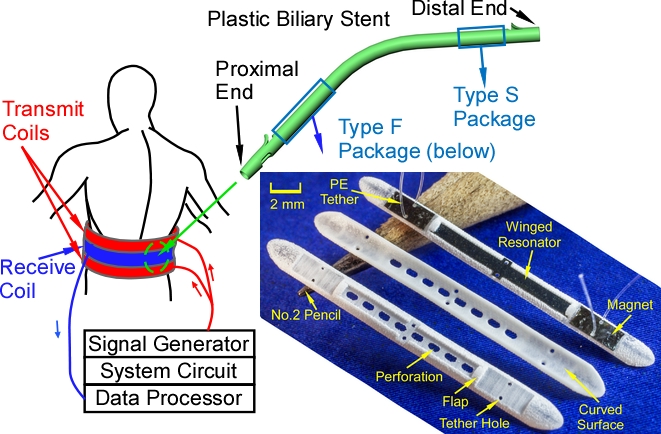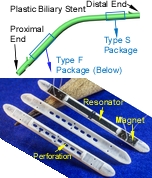
Prior work has shown that wireless magnetoelastic sensors can signal impending stent occlusion, thereby potentially avoiding the most lethal risks of the occlusion. Encapsulation of these sensors within the small inner lumen of the stent remains a critical challenge. The encapsulation must allow the sensors to navigate the curvature and accommodate the contact and bending forces imparted during and after the implantation procedure, while also leaving the sensor open to mechanical interaction with the biomass during the extended period of deployment. This paper is focused on the encapsulation of ribbon-like magnetoelastic sensors (12.5 mm 1 mm 60 μm) within plastic biliary stents (inner diameter of 2.54 mm), which are endoscopically implanted between the liver and small intestine. Two polymer-based package designs with differing stiffness are evaluated: the Type F package is mechanically flexible, while the Type S package is mechanically stiff. The primary benefit of the Type F package is the flexibility during the delivery process while that of the Type S package is in maintaining a planar sensor for a strong signal when the stent is in a curved bile duct. The packages protrude minimally into the stent lumen to reduce the impact on the bile flow; maximum thicknesses of the Type F and S packages are 0.53 mm and 0.74 mm, respectively. Mechanical tests show that both types protect the sensors from forces imparted by a standard introducer, and allow the encapsulated sensors to accommodate bending with a radius of curvature as small as 3 cm. The Type F package has also been tested in situ, in the bile duct of a porcine carcass. The signal from sensors encapsulated by this package exhibits a wireless range of ≈10 cm, at a resonant frequency of 159 kHz and a quality factor of 397.

